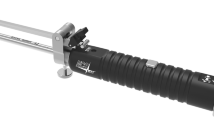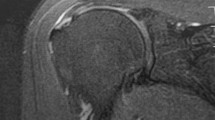Abstract
The reported functional results of rotator cuff repair performed arthroscopically have been good. Only little is known about the cuff integrity after arthroscopic repair and how it influences the outcome. The aim of the study is to set a baseline of what rate of healing response respectively re-tears to expect and how cuff integrity alters the outcome. Fifty-three consecutive patients with an isolated supraspinatus tendon tear were arthroscopically operated and their tendons repaired. All pre- and postoperative data were prospectively collected. At a minimum follow-up after 24 months (average 26.4 months), the integrity of the cuff was evaluated by an open magnetic resonance imaging and the patients’ function and satisfaction were documented and graded to the sex- and age-related Constant-score also using a dynamometer for strength testing. The re-tear rate was 24.5% with 13 non-healed tendons. The Constant-score of all patients improved significantly. The scores of the patients with a re-tear were significantly lower than those of the patient with an intact cuff. That was due to a less good performance in strength testing. The other categories of the Constant-score did not show any differences. The age of the patients with a re-tear was significantly higher. With the exception of age, we did not find any negative prognostic factor for a re-tear, and with the exception of re-tear no other factor influenced the Constant-score. Arthroscopic supraspinatus tendon repair yields a re-tear rate of 25% which is comparable with the results of open or mini/open repair. Cuff integrity influences postoperative strength and Constant-score. Patients older than 65 years show a higher re-tear rate. Therapeutic Level IV is the level of evidence.



Similar content being viewed by others
References
Bennett WF (2003) Arthroscopic repair of anterosuperior (supraspinaus/subscapularis) rotator cuff tears: a prospective cohort with 2- to 4-year follow-up: classification of biceps subluxation/instability. Arthroscopy 19:21–33
Boehm TD (2002) Scores. In: Gohlke F, Hedtmann A (eds) Orthopädie und Orthopädische Chirurgie: Schulter. Thieme, Stuttgart, New York, pp 98–104
Boileau P, Brassart N, Watkinson DJ, Carles M, Hatzidakis AM, Krishnan SG (2005) Arthroscopic repair of full-thickness tears of the supraspinatus: does the tendon really heal? J Bone Joint Surg Am 87-A:1229–1240
Burkhart SS (2001) Arthroscopic treatment of massive rotator cuff tears. Clin Orthop 390:107–118
Burkhart SS, Danaceau SM, Pearce CE Jr (2001) Arthroscopic rotator cuff repair: analysis of results by tear size and repair technique: margin convergence versus direct tendon-to-bone repair. Arthroscopy 17:905–912
Cofield RH, Parvizi J, Hoffmeyer PJ, Lanzer WL, Ilstrup DM, Rowland CM (2001) Surgical repair of chronic rotator cuff tears: a prospective long-term study. J Bone Joint Surg Am 83:71–77
Ellman H, Hanker G, Bayer M (1986) Repair of the rotator cuff. End-result study of factors influencing reconstruction. J Bone Joint Surg Am 68:1136–1144
Galatz LM, Griggs LM, Cameron BD, Iannotti JP (2001) Prospective longitudinal analysis of postoperative shoulder function: a ten-year follow-up study of full-thickness rotator cuff tears. J Bone Joint Surg Am 83:1052–1056
Galatz LM, Ball CM, Teefey SA, Middleton WD, Yamaguchi K (2004) The outcome and repair integrity of completely arthroscopically repaired large and massive rotator cuff tears. J Bone Joint Surg Am 86-A:219–224
Gartsman GM (2001) Arthroscopic rotator cuff repair. Clin Orthop 390:95–106
Gartsman GM, O´Connor DP (2004) Arthroscopic rotator cuff repair with and without arthroscopic subacromial decompression: a prospective, randomized study of one-year outcomes. J Shoulder Elbow Surg 13:424–426
Gerber C, Fuchs B, Hodler J (2000) The results of repair of massive tears of the rotator cuff. J Bone Joint Surg Am 82:505–515
Harryman DT, Mack LA, Wang KY, Jackins SE, Richardson ML, Matsen FA III (1991) Repairs of the rotator cuff: correlation of functional results with integrity of the cuff. J Bone Joint Surg Am 73:982–989
Hawkins RJ, Misamore GW, Hobeika PE (1985) Surgery for full-thickness rotator cuff tears. J Bone Joint Surg Am 67:1349–1355
Jost B, Pfirrmann CW, Gerber C (2000) Clinical outcome after structural failure of rotator cuff repairs. J Bone Joint Surg Am 82:304–314
Kessler MA, Lichtenberg S, Habermeyer P (2003) Reconstruction of big rotator cuff ruptures. A new technique of tendon refixation with the corkscrew suture anchor system. Unfallchirurg 106:826–33
Kim DH, Elattrache NS, Tibone JE, Jun BJ, Delamora SN, Kvitne RS, Lee TQ (2005) Biomechanical comparison of a single-row versus double-row suture anchor technique for rotator cuff repair. Am J Sports Med Nov 10 (Epub ahead of print)
Klepps S, Bishop J, Lin J, Cahon O, Strauss A, Hayes P, Flatow EL (2004) Prospective evaluation of the effect of rotator cuff integrity on the outcome of open rotator cuff repairs. Am J Sports Med 32:1716–1722
Liu SH, Baker CL (1994) Arthroscopically assisted rotator cuff repair: correlation of functional results with integrity of the cuff. Arthroscopy 10:54–60
Ma CB, MacGillivray JD, Clabeaux J, Lee S, Otis JC (2004) Biomechanical evaluation of arthroscopic rotator cuff stitches. J Bone Joint Surg Am 86:1211–1216
Mallon WJ, Misamore G, Snead DS, Denton P (2004) The impact of preoperativesmoking habits on the results of rotator cuff repair. J Shoulder Elbow Surg 13:129–132
Mazzocca AD, Millett PJ, Guanche CA, Santangelo SA, Arciero RA (2005) Arthroscopic single-row versus double-row suture anchor rotator cuff repair. Am J Sports Med 33:1861–1868
Meyer DC, Fucentese SF, Koller B, Gerber C (2004) Association of osteopenia of the humeral head with full-thickness rotator cuff tears. J Shoulder Elbow Surg 13:333–337
Motamedi AR, Urrea LH, Hancock RE, Hawkins RJ, Ho C (2002) Accuracy of magnetic resonance imaging in determining the presence and size of recurrent rotator cuff tears. J Shoulder Elbow Surg 11:6–10
Murray TF Jr, Lajtai G, Mileski RM, Snyder SJ (2002) Arthroscopic repair of medium to large full-thickness rotator cuff tears: outcome at 2- to6-year follow-up. J Shoulder Elbow Surg 11:19–24
Owen RS, Iannotti JP, Kneeland JB, Dalinka MK, Deren JA, Oleaga L (1993) Shoulder after surgery: MR imaging with surgical validation. Radiology 186:443–447
Scheibel MT, Habermeyer P (2003) A modified Mason-Allen technique for rotator cuff repair using suture anchors. Arthroscopy 19:330–333
Sonnabend DH, Watson EM (2002) Structural factors affecting the outcome of rotator cuff repair. J Shoulder Elbow Surg 11:212–218
Spielmann AL, Forster BB, Kokan P, Hawkins RJ, Janzen DL (1999) Shoulder after rotator cuff repair: MR imaging findings in asymptomatic individuals—initial experience. Radiology 213:705–708
Tauro JC (1998) Arthroscopic rotator cuff repair: analysis of technique and results at 2- and3-year follow-up. Arthroscopy 14:45–51
Tuoheti Y, Itoi E, Yamamoto N, Seki N, Abe H, Minagawa H, Okada K, Shimada Y (2005) Contact area, contact pressure, and pressure patterns of the tendon–bone interface after rotator cuff repair. Am J Sports Med 33:1869–1874
Watson Em, Sonnabend DH (2002) Outcome of rotator cuff repair. J Shoulder Elbow Surg 11:201–211
Wilson F, Hinvov V, Adams G (2002) Arthroscopic repair of full-thickness tears of the rotator cuff: 2- to 14-year follow-up. Arthroscopy 18:136–144
Author information
Authors and Affiliations
Corresponding author
Rights and permissions
About this article
Cite this article
Lichtenberg, S., Liem, D., Magosch, P. et al. Influence of tendon healing after arthroscopic rotator cuff repair on clinical outcome using single-row Mason-Allen suture technique: a prospective, MRI controlled study. Knee Surg Sports Traumatol Arthrosc 14, 1200–1206 (2006). https://doi.org/10.1007/s00167-006-0132-8
Received:
Accepted:
Published:
Issue Date:
DOI: https://doi.org/10.1007/s00167-006-0132-8




